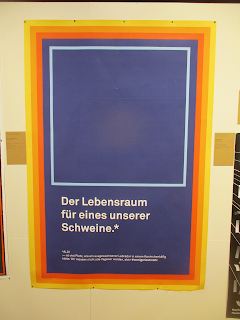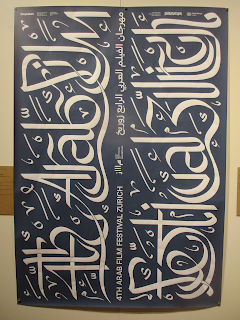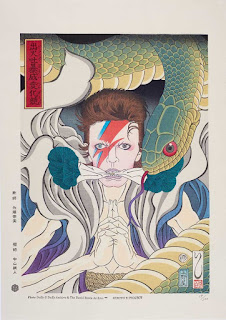Another museum which I hadn't experienced on previous visits to Vienna but was determined to see on this trip was the huge, imposing black, basalt stone edifice that sits in a corner of Vienna's Museum Quarter - mumok. Mumok (museum moderner kunst stiftung ludwig wien) is, it claims, Europe's "largest museum space for modern art". The strikingly modern building designed by architects Ortner & Ortner was opened in 2001, and houses mumok's collection of 10,000 pieces of modern and contemporary art and design made up largely from a series of donated private collections, most notably that of collectors Peter and Irene Ludwig.
As befitting the impressively modern design of the exterior, mumok's current display of art culled from its permanent collections - Reading Time in Space. Modernism at mumok 1910-1955, is displayed in a very modern way. There were lots of slotted partitions dividing the space on which the paintings were hung. It was certainly different to the way in which many other museums display artworks, and whilst experimental and playful, I personally found it a little distracting, and thought it took away the sense of gravitas of certain works. Below are some of the things I found interesting from this current display of mumok's permanent collection of art and design. I would really have liked to see more space given over to displays of the permanent collection as it contains many gems which weren't on display. I visited the other galleries featuring temporary exhibitions of contemporary art, photography and video installation on the other floors of mumok but wasn't suffiently impressed by them to record them here.
Theo von Doesburg - Komposition 8, 1919
Hans Arp - Portfolio of Serigraphs and one collage 1959, Croix, 1917, Constellation, 1932
Josef Hoffman - Chair/Table, 1905
Wiener Werkstätte - Glass and flatware, c. early 20th C.
Joan Miró - Spanish Dancer tapestry rug, c.1965 & Gerrit Reitveld - Red Blue chair, 1917
Meret Oppenheim - Traccia table, 1939 & Man Ray - Daring Gift, 1921/1974
Fernand Léger - Nature morte aux fruits, 1927
František Kupka - Nocturne, 1910-11
Egon Schiele - Small Tree in late Autumn, 1911
Otto Freundlich - Forces, 1934
Piet Mondrian - Composition with Double Line and Blue (unfinished), 1935
Oskar Schlemmer - Group of Three with One Nude Seen From the Back, 1929
Max Ernst - Aus der Mappe/From the Portfolio: Fiat Modes Pereat Ars, 1919
Robert Delauney - White Relief, 1936
László Moholy-Nagy - Komposition Q V III, 1922
Victor Servranckx - Painting Opus 45, 1923
Michail Larionov - Figurine for the Ballet "Le Marche Funèbre... 1919
Pablo Picasso - Seated Woman with Green Scarf, 1960
René Magritte - The Voice of Blood, 1959
mumok
museum moderner kunst stiftung ludwig wien
Museumsplatz 1,
A-1070
Wien
















































































